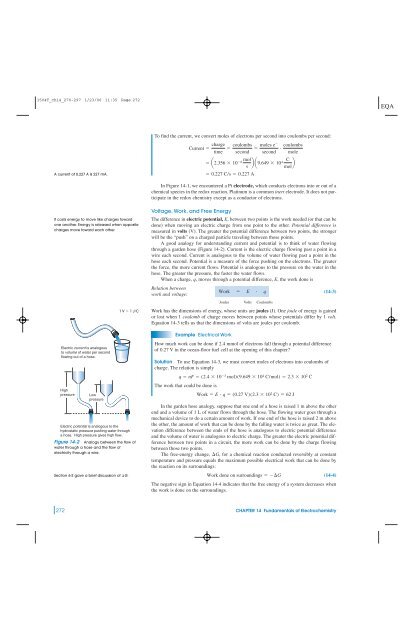Fundamentals of Electrochemistry - W.H. Freeman
Fundamentals of Electrochemistry - W.H. Freeman
Fundamentals of Electrochemistry - W.H. Freeman
You also want an ePaper? Increase the reach of your titles
YUMPU automatically turns print PDFs into web optimized ePapers that Google loves.
1504T_ch14_270-297 1/23/06 11:35 Page 272<br />
A current <strong>of</strong> 0.227 A is 227 mA.<br />
To find the current, we convert moles <strong>of</strong> electrons per second into coulombs per second:<br />
Current charge<br />
time<br />
coulombs<br />
second<br />
0.227 C/s 0.227 A<br />
moles e<br />
<br />
second<br />
coulombs<br />
mole<br />
mol<br />
a2.356 106 b a9.649 C 104<br />
s mol b<br />
In Figure 14-1, we encountered a Pt electrode, which conducts electrons into or out <strong>of</strong> a<br />
chemical species in the redox reaction. Platinum is a common inert electrode. It does not participate<br />
in the redox chemistry except as a conductor <strong>of</strong> electrons.<br />
It costs energy to move like charges toward<br />
one another. Energy is released when opposite<br />
charges move toward each other.<br />
Electric current is analogous<br />
to volume <strong>of</strong> water per second<br />
flowing out <strong>of</strong> a hose.<br />
High<br />
pressure<br />
Low<br />
pressure<br />
1 V 1 J/C<br />
Electric potential is analogous to the<br />
hydrostatic pressure pushing water through<br />
a hose. High pressure gives high flow.<br />
Figure 14-2 Analogy between the flow <strong>of</strong><br />
water through a hose and the flow <strong>of</strong><br />
electricity through a wire.<br />
Section 6-2 gave a brief discussion <strong>of</strong> G.<br />
Voltage, Work, and Free Energy<br />
The difference in electric potential, E, between two points is the work needed (or that can be<br />
done) when moving an electric charge from one point to the other. Potential difference is<br />
measured in volts (V). The greater the potential difference between two points, the stronger<br />
will be the “push” on a charged particle traveling between those points.<br />
A good analogy for understanding current and potential is to think <strong>of</strong> water flowing<br />
through a garden hose (Figure 14-2). Current is the electric charge flowing past a point in a<br />
wire each second. Current is analogous to the volume <strong>of</strong> water flowing past a point in the<br />
hose each second. Potential is a measure <strong>of</strong> the force pushing on the electrons. The greater<br />
the force, the more current flows. Potential is analogous to the pressure on the water in the<br />
hose. The greater the pressure, the faster the water flows.<br />
When a charge, q, moves through a potential difference, E, the work done is<br />
Relation between<br />
work and voltage:<br />
Joules Volts Coulombs<br />
(14-3)<br />
Work has the dimensions <strong>of</strong> energy, whose units are joules (J). One joule <strong>of</strong> energy is gained<br />
or lost when 1 coulomb <strong>of</strong> charge moves between points whose potentials differ by 1 volt.<br />
Equation 14-3 tells us that the dimensions <strong>of</strong> volts are joules per coulomb.<br />
Example Electrical Work<br />
How much work can be done if 2.4 mmol <strong>of</strong> electrons fall through a potential difference<br />
<strong>of</strong> 0.27 V in the ocean-floor fuel cell at the opening <strong>of</strong> this chapter?<br />
Solution To use Equation 14-3, we must convert moles <strong>of</strong> electrons into coulombs <strong>of</strong><br />
charge. The relation is simply<br />
q nF (2.4 10 3 mol)(9.649 10 4 C/mol) 2.3 10 2 C<br />
The work that could be done is<br />
Work E<br />
q<br />
Work E q (0.27 V)(2.3 10 2 C) 62 J<br />
In the garden hose analogy, suppose that one end <strong>of</strong> a hose is raised 1 m above the other<br />
end and a volume <strong>of</strong> 1 L <strong>of</strong> water flows through the hose. The flowing water goes through a<br />
mechanical device to do a certain amount <strong>of</strong> work. If one end <strong>of</strong> the hose is raised 2 m above<br />
the other, the amount <strong>of</strong> work that can be done by the falling water is twice as great. The elevation<br />
difference between the ends <strong>of</strong> the hose is analogous to electric potential difference<br />
and the volume <strong>of</strong> water is analogous to electric charge. The greater the electric potential difference<br />
between two points in a circuit, the more work can be done by the charge flowing<br />
between those two points.<br />
The free-energy change, G, for a chemical reaction conducted reversibly at constant<br />
temperature and pressure equals the maximum possible electrical work that can be done by<br />
the reaction on its surroundings:<br />
Work done on surroundings G<br />
(14-4)<br />
The negative sign in Equation 14-4 indicates that the free energy <strong>of</strong> a system decreases when<br />
the work is done on the surroundings.<br />
272 CHAPTER 14 <strong>Fundamentals</strong> <strong>of</strong> <strong>Electrochemistry</strong>

















